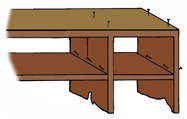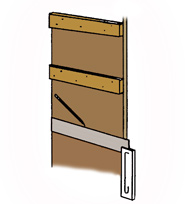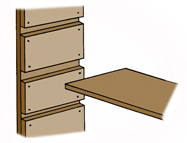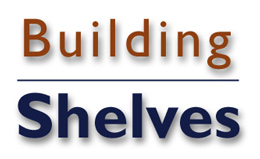|

FIG. 1 - You can make
basic, non-adjustable shelving from solid boards of many sizes and widths.

FIG. 2 - Small cleats
make supports for non-adjustable shelves.

FIG. 3 - The way the
nails are driven affects the strength of a shelf bracket.

FIG. 4 - Larger cleats
provide stronger supports for shelves that must carry heavy loads.
|

ADJUSTABLE AND NON-ADJUSTABLE
WOOD SHELVING
- Additional shelving is useful in almost every home and can be added quickly
and easily. And it need not be expensive.
- Consider adding shelves in your basement, attic, kitchen and other
areas to help keep stored materials much neater and to save time when
looking for stored items.
- You can make basic, non-adjustable shelving from solid boards of almost
any size or width (Fig. 1). Such shelving is easy to make and provides
adequate support for normal storage and shelving needs.
- The disadvantage of non-adjustable shelving is that some stored objects
may be too tall or short, thus wasting space on the shelving you construct.
- You can overcome this problem by making shelves for tall objects and other
shelves for short objects. Give a little thought to the materials you
plan to store so you can design the shelves to minimize wasted space.
- Non-adjustable shelving is normally used in closets, attics, basements,
work areas, etc., where appearance and adjustability are not very important.
These shelves can be nailed together with support pieces to provide
the structural strength required.
- Small cleats can provide the needed support for other types of non-adjustable
shelves (Fig. 2). These shelves can be made as wide or as long as necessary.
- Wood shelving of this type should have supports every 3'. If the shelving
will hold extremely heavy loads, use supports as frequently as every
2-1/2'.
- Use extreme care when nailing the cleats onto the side boards. Use a T-square
or a level to make sure the shelves are in the proper position and are
evenly spaced at all points.
- The way in which you drive the nails will increase or decrease the ability
of the shelves to carry heavy loads (Fig. 3).
- For example, nails driven at an upward angle are likely to pull out when
a heavy load is placed on them.
- If the nails are driven straight into the supporting wall, the cleat has
a fair supporting strength. However, nails driven at a downward angle
greatly increase the ability of the cleat to carry a heavy load. Keep
this in mind when nailing cleats for supporting shelves.
- Wider cleats, as shown in Fig. 4, provide a great deal of structural strength.
They also make it possible for the shelves to be moved in and out as
necessary.
- If you are designing shelves to carry extremely heavy loads, use wide cleats and nail them firmly into position.
|








